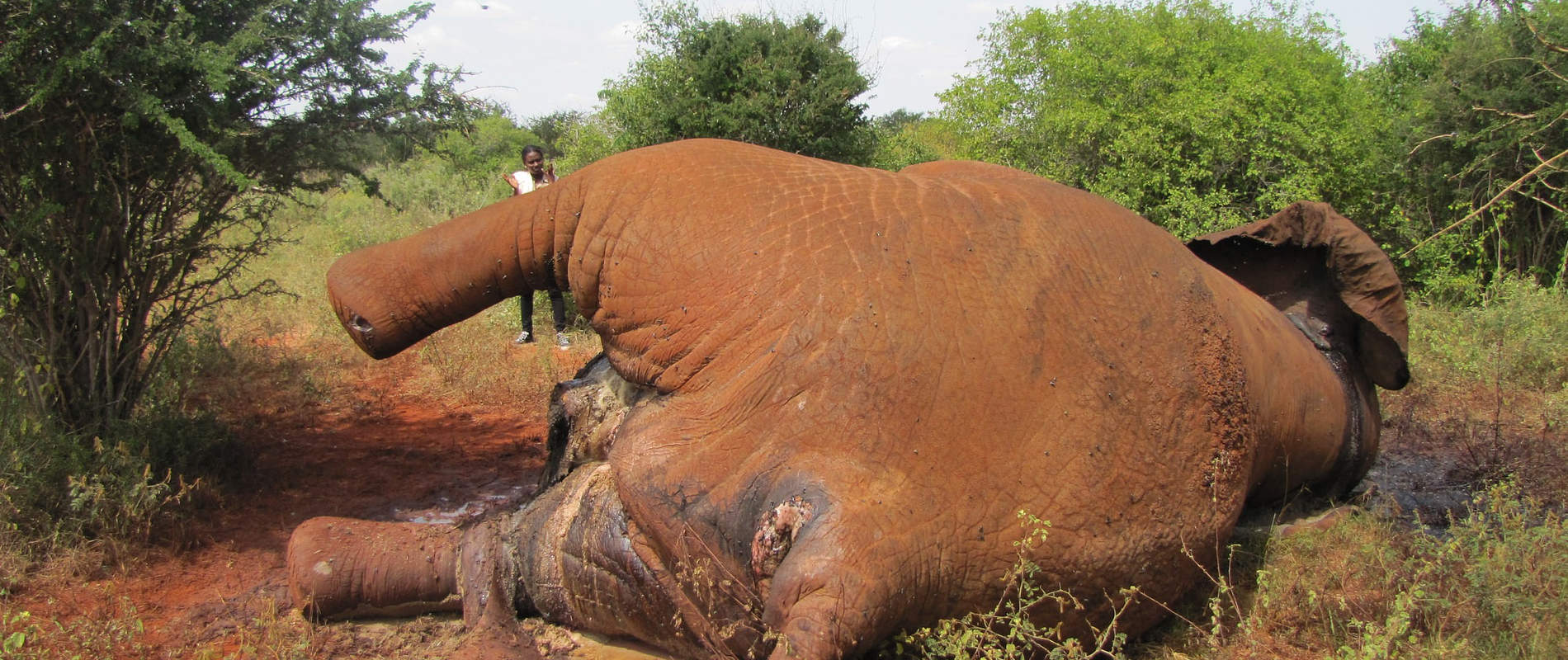FIELD VETERINARY REPORT FOR TSAVO MOBILE VET UNIT FOR THE MONTH OF JUNE 2016 The month under review witnessed an increase in wildlife cases of various species with different ailments
FIELD VETERINARY REPORT FOR TSAVO MOBILE VET UNIT FOR THE MONTH OF JUNE 2016
The month under review witnessed an increase in wildlife cases of various species with different ailments. Among these cases were two autopsies of elephants that were victims of poaching, an elephant bull treated for an arrow injury near Ngulia Rhino sanctuary, a cheetah treated for a leg injury near Ziwani gate and a leopard incriminated for killing a standard gauge railway worker was euthanized after being examined and found to be too old to survive in the wild. In Tsavo East two old recumbent elephant cows were also euthanized after being assessed and found beyond any medical help.
CASE#1 TREATMENT OF AN ELEPHANT BULL
Date of intervention: 8th June 2016
Animal: African Elephant
Sex: Male
Age: Young adult
Location: Ngulia, Tsavo West
History
This lame elephant was seen by KWS rangers near a water point in Ngulia Rhino valley moving with a lot of difficulty and pain. The team rushed to the area to find the elephant under a tree nearby with a swollen left hind limb at the knee joint area and barely able to bare weight on it.
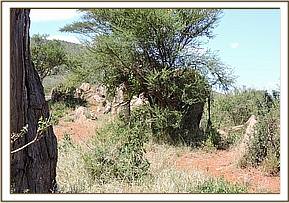

Immobilization, examination and treatment
A dan-inject dart was prepared and filled with 16 mgs of Etorphine. The elephant was darted from a vehicle and moved a short distance before going down on the right side.
The necrotic tissues were cut off and the infected wound washed with water mixed with Hydrogen peroxide. An arrow head was retrieved from the necrotic tissues.
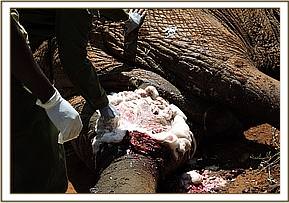

Further examination revealed suppurative inflammation of the left knee joint rendering it non-functional. Tincture of iodine was splashed on the wound, which was then sprayed with Oxytetracycline spray and covered with green clay. Long acting antibiotics and anti-inflammatory drugs were administered parenterally.
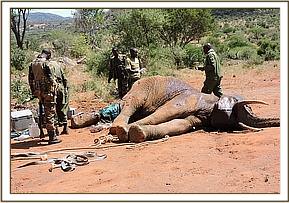

Prognosis
He struggled to wake up and had to be assisted by use of ropes wrapped around the tusks. Prognosis is guarded to poor.
CASE#2 TREATMENT OF A CHEETAH
Date of intervention: 11th June 2016
Animal: Cheetah
Sex: Female
Age: Adult
Location: Ziwani, Tsavo West
History
The Cheetah was reported lame by lodge workers who saw it lying nearby with minimal movement. The team rushed to the area to find the thin Cheetah lying under a shade. Drugs were prepared for the darting process.
Immobilization, examination and treatment
50 mgs of Etorphine mixed with 1 mg of Meditomidine was used to immobilize the Cheetah. She was down in 4 minutes. The vet checked the lame hind limb but no external injury was evident. It is possible that the in. Long acting Amoxicillin and Dexamethasone was administered parenterally.
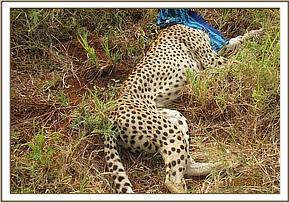
Reversal
Meditomidine was reversed by use of Atipemazole Hcl.
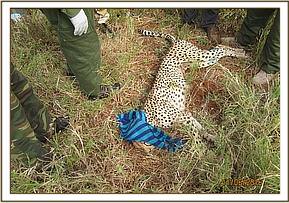
Prognosis
Prognosis was guarded. Follow up did not yield anything as the Cheetah disappeared after treatment.
CASE#3 MANAGEMENT OF A PROBLEMATIC LEOPARD
Date of intervention: 12th June
Animal: Leopard
Sex: Male
Age: Adult
Location: Tsavo River, Tsavo East
History
There has been complaints of man eating Leopard that killed a standard gauge Railway worker a month ago. A decision was made to trap the leopard and examine it. It was finally trapped on 12th June and brought to the vet clinic for examination.
Immobilization, examination and management
The leopard was immobilized using 100 mgs of Ketamine mixed with 1 mg of Meditomidine propelled in a dan-inject dart gun. The leopard was removed from the trap cage and placed in a tarpaulin stretcher.
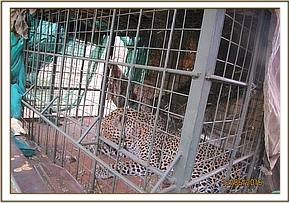

Examination revealed a missing left upper canine and a broken right one. Loss of canines presents a challenge to predators in terms of killing prey hence they usually resort to livestock or even human predation.
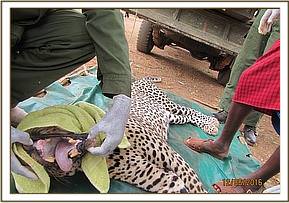
Translocation was not an option and euthanasia was recommended. 10Mls of 20% Pentobarbitone sodium rapid IV was used.
CASE#4 ELEPHANT AUTOPSY REPORT
Date: 15th June 2016
Animal: African Elephant
Sex: Male
Age: Adult
Location: Lualenyi Ranch, Tsavo West
History
A report was made by KWS rangers regarding an elephant carcass that was sighted in Lualenyi ranch and aged at about four days old. The request was for autopsy to be undertaken to know the cause of death.
General Examination
The carcass was male lying on the right flank with the face chopped off and tusks missing. It was in an advanced state of putrefaction. The prepucial area was eaten away by scavengers and part of the colon was exposed. The skin on the left flank was removed exposing the subcutis which that was clear with no injuries seen. The carcass was flipped over exposing the right flank. Blood clots were observed on the skin surface near the paralumbar area. On skin removal diffuse hemorrhagic patches were observed with a penetrating wound going deep into the abdominal cavity. On opening the abdominal cavity, the peritoneal fluid was mixed with ingester and had signs of inflammation. The wound was typical of an arrow wound but the arrow head was not retrieved due to advanced decomposition.

CASE#5 RESCUE OF A SERVAL CAT
Date: 16th June 2016
Animal: Serval Cat
Sex: Female
Age: Kitten
Location: Taveta, Tsavo West
Rescue
A tiny kitten was found by a community member who kept it overnight and took it to Taveta KWS station the next morning who reported receipt of the kitten. Inquiries to Nairobi orphanage were made but as plans were being made to transport it there, DSWT volunteered to host the kitten in Nairobi for eventual release back to the wild. The kitten was airlifted to Nairobi DSWT stockade for care.
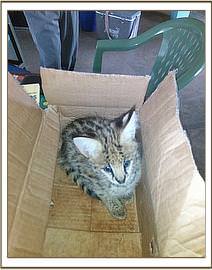
CASE#6 ELEPHANT AUTOPSY REPORT
Date of autopsy: 17th June 2016
Animal: African Elephant
Species: Loxodanta Africana
Sex: Male
Age: Adult
Location: Jipe, Tsavo West
History
A report was made by KWS rangers of an elephant carcass that was sighted in the Jipe area of southern Tsavo West and aged at about 2 days old since time of death. The request was for autopsy to be undertaken to know the cause of death.
General Examination
The carcass was male lying on the left flank with the face chopped off and tusks missing. It was in mid-state of putrefaction and bloated. The skin was examined for possible external wounds and three penetrating wounds were observed, one penetrating the left ear and entering the body at the right scapula blade area, a second one slightly higher and a third entering near the spinous process of the lumbar vertebrae. The skin was opened and the penetrating wound traced through the thick muscles, and penetrating the scapula blade and finally hitting and severing the lumbar vertebrae into two before disappearing into the chest cavity. Massive bleeding and muscle lacerations were also evident. The carcass was rolled over to expose the left flank and no lesions were observed. Two high caliber cartridges were found near the carcass.
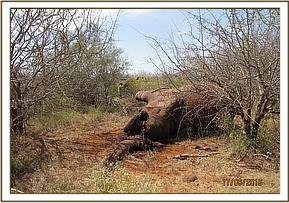

Cause of Death
Cause of death was a gunshot wound that severed the spinal cord and blood vessels at the anterior lumbar areas leading to massive haemorrhage, shock and death.
CASE#7 TREATMENT OF AN ELEPHANT CALF
Date of intervention: 20th June
Animal: African Elephant
Species: Loxodanta Africana
Sex: Male
Age: Calf
Location: Ngutuni, Tsavo east
History
This lame elephant calf was seen by DSWT stockade staff near the new standard gauge railway construction site in Ngutuni moving with a lot of difficulty and pain and accompanied by its mother. The team rushed to the area to find the mother and calf nearby with a swollen left hind limb at the fetlock joint area and barely able to bare weight on it.
Immobilization, examination and treatment
A dan-inject dart was prepared and filled with 16 mgs of Etorphine and the mother darted first to prevent separation and allow the calf to be treated. She moved a short distance and went down on the left side. The nearly one year old calf was physically restrained and immobilized with 2 mgs of Etorphine by hand injection.

The leg was examined and no external wound was observed but the fetlock joint was swollen and firm. From the old skin lesions the probable cause could be a wire snare that eventually healed.

Long acting antibiotics and anti-inflammatory drugs were administered parenterally.
Reversal
The calf was revived first followed by the mother by use of Diprenorphine. The calf struggled to wake up and had to be assisted by hand push and joined his mother who woke up seconds later.
CASE#8 MANAGEMENT OF A SICK ELEPHANT COW
Date of intervention: 21st June 2016
Animal: African Elephant
Sex: Female
Age: Adult-old
Location: Irima, Tsavo east
History
An Elephant cow was reported to be lying down flat under a tree by tourists visiting the area on a game drive. The team rushed in to find the recumbent elephant cow lying flat on its right side with struggle marks evident around her. On closer examination she was found to be alive but was in very poor body condition; assessed at 2 in a body score of up to five.
Immobilisation, treatment and management
She was administered with 3 mgs Etorphine IV then injected Dexamethasone and Catasol intramuscularly and long acting antibiotics. Anesthesia was reversed and ropes tied to a vehicle used to assist her onto her feet. She could only make it to a sitting position and could not rise even with assistance. After several attempts it was obvious she was old and too thin to stand up and a decision was made to euthanize to end her pain. The tusks were removed and handed to KWS security in Tsavo east for safe keeping.
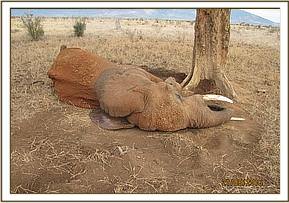
CASE#9 TREATMENT OF AN INJURED ELEPHANT BULL
Date: 22nd June 2016
Species: Elephant
Sex: Male
Age: Adult
Place: Murondo, Tsavo east
History
This elephant bull was reported to have been hit by a train and survived near Ndara area of Tsavo East where another bull was killed earlier in the month. He lost the right tusk and the right eye amongst other wounds. He was reported sickly and not feeding near Murondo KWS camp.
Immobilization, examination and treatment
10 mgs of Etorphine in a dan-inject dart was prepared and loaded into a dart gun. He was darted in the rump and went down after 12 minutes.
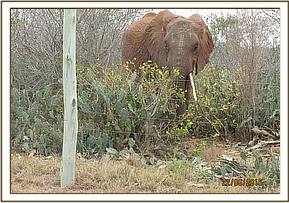
There was a big cut wound above the right orbital bone that connected with the now destroyed and septic lobe. Dirt was removed from the wound before the necrotic tissue was removed and the wound cleaned using water mixed with Hydrogen peroxide and opticlox applied.


An intravenous administration of 30 cc Dexamethasone Hcl was given through the ear vein and 60 cc of long acting Amoxicillin injected intramuscularly. Repeat treatment was advised after one month.
Reversal
Drug reversal was done by administration of Diprenorphine Hcl at three times the etorphine dose. The bull woke up and moved away slowly.
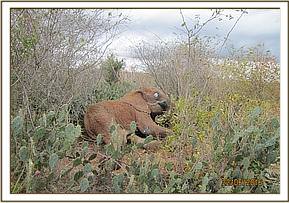
Prognosis
Prognosis was poor.
CASE#10 EXAMINATION OF A GIRAFFE CARCASS
Date: 22nd June 2016
Species: Giraffe
Sex: Male
Age: Adult
Place: Taita ranch, Tsavo
History and examination
Reports of deaths in Giraffes were received from KWS teams that patrol the Taita ranches which hosts a big number of wildlife. The place was visited and the carcass reported as fresh found to be more than a month old with all the soft tissues decayed away. The cause of death could not be determined.
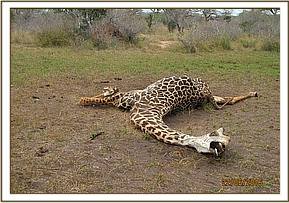
CASE#11 MANAGEMENT OF A SICK ELEPHANT COW
Date of intervention: 22nd June 2016
Animal: African Elephant
Sex: Female
Age: Adult-old
Location: Dida Harea, Tsavo east
History
An Elephant cow was reported to be lying down flat by KWS rangers. The team rushed in to find the recumbent elephant cow flat on its left side with evidence it had been struggling for some time.

Immobilization, examination and treatment
She was administered with 3 mgs Etorphine IV then injected Dexamethasone intramuscularly. Ropes were tied to a vehicle to assist her to her feet. However she was unable to stand and after several attempts it was obvious she was too old to stand up.

A decision was made to euthanize to end her suffering. The tusks were removed and handed to KWS security in Tsavo East for safe keeping.
CASE#12 TREATMENT OF AN ELEPHANT ORPHAN
Date of intervention: 27th June 2016
Animal: African Elephant
Species: Loxodanta Africana
Sex: Male
Age: Young
Location: Voi stockade, Tsavo East
History
An elephant calf was separated from the orphan herd at Voi and was lost for two days. It was finally traced and taken back to the stockade but had sustained several bite wounds from a suspected lion attack. Luckily all the wounds were soft tissue and muscle injuries.
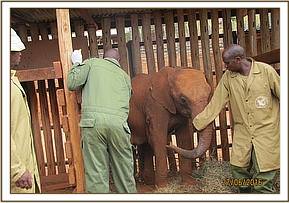

Immobilization, examination and treatment
The wounds were attempted to be cleaned before immobilization but the orphan became aggressive and had to be immobilized using 4 mgs of Eetorphine Hcl. The infected wound was washed with water mixed with Hydrogen peroxide. Tincture of iodine and Oxytetracycline spray were applied to the wound before it was covered with green clay. Long acting antibiotics and anti-inflammatory drugs were administered parenterally.
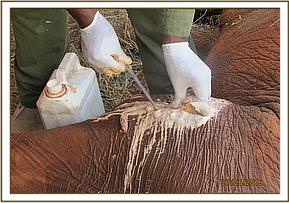

Prognosis
Prognosis is good
CASE#13 TREATMENT OF AN INJURED ELEPHANT BULL
Date: 29th June 2016
Species: Elephant
Sex: Male
Age: Adult
Place: Airstrip, Amboseli National Park.
History
The elephant bull was spotted in Amboseli area by Big life airplane on patrol with a wound to the left rump with blood oozing from it. They notified the vet team who were airlifted the next morning by DSWT aircraft to the area to find the injured bull near the main airstrip.
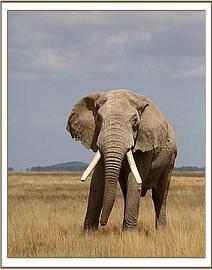
Immobilization, examination and treatment
18 mgs of Etorphine in a dan-inject dart was prepared and loaded into a dart gun. A vehicle was used to trail and dart the bull. He was darted in the rump and kept in open ground by the vehicle. He went down after a record 20 minutes on the left flank.
There was a bleeding spear wound to the left the rump. On probing the wound was discovered to be deep. It was cleaned using water mixed with Hydrogen peroxide. Tincture of iodine was then applied and Oxytetracycline spray administered. Finally the wound was covered in wetted green clay.
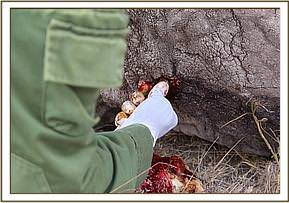
An intravenous administration of 50 cc Dexamethasone Hcl was given through the ear vein and 200 cc of long acting Amoxicillin injected intramuscularly.
Reversal
Drug reversal was done by administration of Diprenorphine Hcl at three times the Etorphine dose. The bull woke up and moved away slowly.
Acknowledgement
The unit would like to appreciate the support of its sponsors ViER PFOTEN through the David Sheldrick Wildlife Trust (DSWT) for their continued support. We also thank Kenya Wildlife Service through the Assistant director Tsavo conservation area and the head, veterinary and capture services department for their immense support to the unit.
Reported by Dr Jeremiah Poghon
